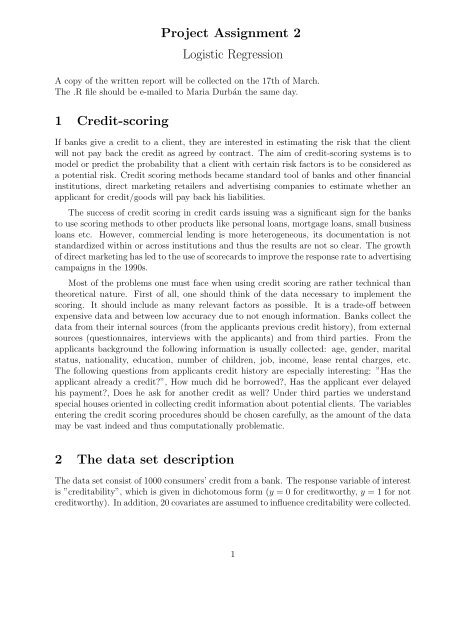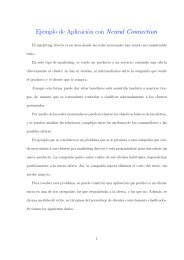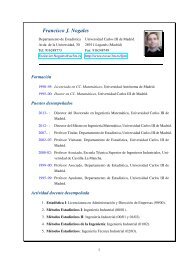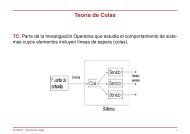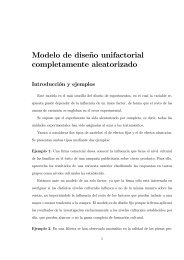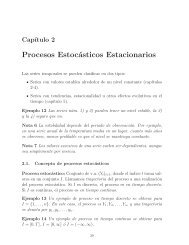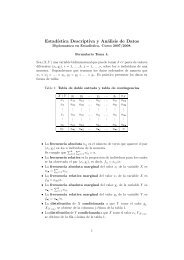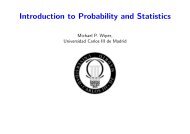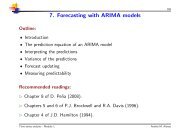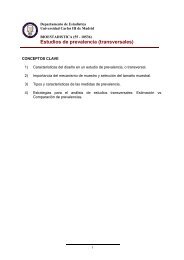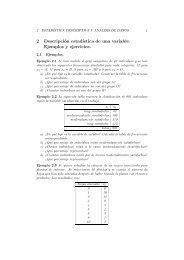Project Assignment 2 Logistic Regression 1 Credit-scoring 2 The ...
Project Assignment 2 Logistic Regression 1 Credit-scoring 2 The ...
Project Assignment 2 Logistic Regression 1 Credit-scoring 2 The ...
You also want an ePaper? Increase the reach of your titles
YUMPU automatically turns print PDFs into web optimized ePapers that Google loves.
<strong>Project</strong> <strong>Assignment</strong> 2<strong>Logistic</strong> <strong>Regression</strong>A copy of the written report will be collected on the 17th of March.<strong>The</strong> .R file should be e-mailed to Maria Durbán the same day.1 <strong>Credit</strong>-<strong>scoring</strong>If banks give a credit to a client, they are interested in estimating the risk that the clientwill not pay back the credit as agreed by contract. <strong>The</strong> aim of credit-<strong>scoring</strong> systems is tomodel or predict the probability that a client with certain risk factors is to be considered asa potential risk. <strong>Credit</strong> <strong>scoring</strong> methods became standard tool of banks and other financialinstitutions, direct marketing retailers and advertising companies to estimate whether anapplicant for credit/goods will pay back his liabilities.<strong>The</strong> success of credit <strong>scoring</strong> in credit cards issuing was a significant sign for the banksto use <strong>scoring</strong> methods to other products like personal loans, mortgage loans, small businessloans etc. However, commercial lending is more heterogeneous, its documentation is notstandardized within or across institutions and thus the results are not so clear. <strong>The</strong> growthof direct marketing has led to the use of scorecards to improve the response rate to advertisingcampaigns in the 1990s.Most of the problems one must face when using credit <strong>scoring</strong> are rather technical thantheoretical nature. First of all, one should think of the data necessary to implement the<strong>scoring</strong>. It should include as many relevant factors as possible. It is a trade-off betweenexpensive data and between low accuracy due to not enough information. Banks collect thedata from their internal sources (from the applicants previous credit history), from externalsources (questionnaires, interviews with the applicants) and from third parties. From theapplicants background the following information is usually collected: age, gender, maritalstatus, nationality, education, number of children, job, income, lease rental charges, etc.<strong>The</strong> following questions from applicants credit history are especially interesting: ”Has theapplicant already a credit?”, How much did he borrowed?, Has the applicant ever delayedhis payment?, Does he ask for another credit as well? Under third parties we understandspecial houses oriented in collecting credit information about potential clients. <strong>The</strong> variablesentering the credit <strong>scoring</strong> procedures should be chosen carefully, as the amount of the datamay be vast indeed and thus computationally problematic.2 <strong>The</strong> data set description<strong>The</strong> data set consist of 1000 consumers’ credit from a bank. <strong>The</strong> response variable of interestis ”creditability”, which is given in dichotomous form (y = 0 for creditworthy, y = 1 for notcreditworthy). In addition, 20 covariates are assumed to influence creditability were collected.1
2.0.1 Description of the variables• Y (response variable): a factor with levels ’good’, ’bad’. Payment of previous loans(good means “good payer”).• X 1 (Account): a factor with levels ’no running account’, ’good running’, ’bad running’,quality of the credit clients bank account.• X 2 (Month): a numeric vector, duration of loan in months.• X 3 (Ppag): a factor with levels ’pre good payer’ ’pre bad payer’, if the client previouslyhave been a good or bad payer.• X 4 (Use): a factor with levels ’personal’ ’professional’, the intended use to which theloan is made.• X 5 (DM): a numeric vector, the size of loan in monetary units.• X 6 (Sex): a factor with levels ’woman’ ’man’, sex of the client.• X 7 (CivSt): a factor with levels ’alone’ ’not alone’, civil state of the client.<strong>The</strong> data set is divided into two samples of 500 individuals each, a training sample “training.txt”(used to estimate the model) a testing sample (used to validate the model) “testing.txt”3 <strong>Assignment</strong>1. Fit seven simple logistic regression model, one for each variable and comment theresults (check whether the linear assumption is correct for the continuous covariates).2. Fit a multivariate logistic regression model (take into account that the quality of thecredit clients bank account and previous behavior of the client when paying loans mightinteract with other variables) and use the likelihood ratio test to determine which termsshould be dropped from the model and compare the result with the model obtainedusing AIC criteria.3. Based of this last model, obtain 90% confidence intervals for the odds ratios for loanuse and civil state.4. Interpret the coefficients of the model obtained in terms of odds-ratios.5. Conduct the appropriate goodness of fit test, state the hypothesis, the decision ruleand the conclusion.6. Use the deviance residuals to check the adequacy of the model.7. Use the H matrix to identify outlying X observations.8. Do the appropriate plots for detecting influential observations.2
9. To predict the credit status, you must identify the optimal cutoff. On the basis of thetraining sample, find the total error rate, the error rate for persons considered “goodpayers”, and the error rate for persons considered “bad payers”, for 100 different cutoffpoints between 0.1 and 0.9. Which of the cutoffs minimizes the total error rate?Looking at the area under the ROC curve, what do you conclude?10. Use the prediction rule obtained before to predict the credit status of the other 500individuals in the file “testing.txt”. What are the total and the two component predictionerror rates for the validation sample? How do these error rates compare withthe ones obtained in the model fitting sample?11. Combine the model fitting and validation sample and fit the model selected previouslyto the combined data. Are the estimated coefficients and the estimated standard errorssimilar to the ones obtained for the model fitting data set? Should they be? Comment.3


